
Atlas F1 GP Editor
Ove Andersson recently announced his retirement as team principal of the Toyota team. After more than three decades leading the Japanese company's motorsports programme, Andersson's void will surely be hard to fill. But is he really retiring? Atlas F1's David Cameron takes a look back at Andersson's career and talks to the Swede about his ongoing involvement with the company he loves
1971 was his big break - he signed with the dominant Alpine Renault team, and immediately won the prestigious Monte Carlo Rally before going on to claim the European Championship the following year. It was at this time that he also started his long involvement with the car company with which he would become so synonymous - Andersson Motorsport was formed in 1972 in his home town to prepare and race the Toyota Celica 1600GT in international racing, taking ninth place on debut at the RAC Rally.
Andersson continued to spread his time between running his nascent company and driving for other manufacturers (including a few races with current Ferrari Team Principal Jean Todt as co-driver in 1973), taking a World Rally Championship win at the Safari Rally in 1975, the same year that Toyota claimed their first win in the competition with Hannu Mikkola (at the 1000 Lakes Rally in Finland). It was the spur Andersson needed; he moved his company to Brussels, renaming it Toyota Team Europe (TTE) to reflect the increased involvement coming from the motoring giant.
Retirement from active racing focused Andersson's mind on the team, and he set about building on the relationship with Toyota. He moved the team once more in 1979, this time to Cologne, setting up shop across the road from the company's major manufacturing plant in Germany so as to cut down the time it took for improvements to come down the pipe. TTE concentrated on specialised rallies during the early eighties, in particular the Safari, claiming wins before making a concentrated effort on the championship later in the decade.
Andersson sold TTE to Toyota in 1993, securing his own financial future and that of the team in one stroke. And with the pecuniary might of the auto manufacturer behind him he began to explore other areas of motorsport - in 1997 the team commenced the design process of the sportscar which was to compete so spectacularly at Le Mans the following two years. The team's cars lead easily both times, falling away from a win in the 23rd hour in the first race before claiming second in 1999, and would have gone on to ultimately claim the top spot if the team hadn't switched focus to Formula One.
Toyota would not have come to Formula One were it not for Ove Andersson. The board of Toyota Motor Corporation (TMC) were certainly aware of the sport, and were particularly covetous of the public relations help their great rival Honda had gained over their years of competing (and winning) in the sport over the years, but it was Andersson (no stranger to the TMC board, even then) who had built up the motorsport arm of the company to such and extent that it was a possibility.
Andersson knew of the board's interest in competing at the pinnacle of motorsport and made his pitch - give me the resources and I'll build the team you need. It worked - TTE became TMG (Toyota Motorsport GmbH), the funds were transferred to build a start of the art factory on their existing site, and the process of building a new Formula One team from scratch begun.
It was Andersson too who persuaded the TMC board to let him go his own way - it had previously been assumed that a manufacturer wishing to enter the sport should approach an existing team as an engine provider - whereas he understood the public relations gold mine that would come from the team creating everything under one roof and competing under one name - Toyota.
Another facet of the build up to the team's debut in Formula One was the people - TTE had a large number of people whose abiding love was motor racing, and motor racing people intrinsically want to be in Formula One to show their abilities against the best competition there is. Andersson understood this, and built the team around the people he already had, guaranteeing loyalty and a sense of family in a paddock famous for its fickleness.
Being based in Germany, far away from the garagistes in England, gave the team another reason to pull together. Not that they needed many - a large number of the senior positions were filled by people who had worked together for as long as they could remember. Team Manager Ange Pasquali has been with the team for over decade. General Manager of Operations Richard Cregan has been there for over two.
Bolstered by specialist appointments as and when the need arose (Chief Designer Gustav Brunner was brought to the team in 2001, and more recently Technical Director Mike Gascoyne came onboard) the team worked together, for each other and to help build Andersson's dream. The first engine was bench tested in 2000. A chassis was built and tested at circuits around the world in 2001. And the team made its racing debut with Allan McNish (formerly a Toyota sportscar driver) and Mika Salo piloting the red and white cars in Melbourne in early 2002.
But time was running out for Andersson. Toyota has always had a policy of compulsory retirement at the age of 65, which dates back to company chairman Dr. Shoichiro Toyota, who himself retired to the position of honourary chairman when he reached the milestone. Cognizant of the need to maintain stability in the infancy of the team (and in an extraordinary gesture for a company, which clearly showed the respect they held for the man) Andersson was given a one year reprieve so as to calm the waters and steer the team through what is a traditionally difficult time for a Formula One team - its second year.
Andersson was to be kept on as an advisor to the company. He noted at the time "I want to thank Toyota for having given me chances in its various motorsport activities, and I am proud to continue to support the company in my new role. Thirty years ago I started with three people in Belgium. Since then I have set a lot of targets and I have achieved them together with Toyota. Together, we manufactured Toyota's first ever Formula 1 car. When it appeared on the grid at the Australian GP in 2002, it was an amazing feeling for me that I will never forget. I am sure Toyota will succeed in Formula 1 and I look forward to seeing its first victory in the future."
And that, seemingly, was that.
* * *
Or was it? At last week's launch of their new car Tomita was front and centre, thanking everyone for coming and making the right noises about the coming season before, remarkably, handing over to Andersson for a few words. As usual he put the focus squarely on the people who make up the team: "We've been in racing now for four years - I think we have learnt a lot. This is our fourth car, and I've always said the biggest challenge is maybe not the car or the race itself, but it is making a team out of so many people. I can see that this is starting to gel together nicely, and therefore I believe this season we are going to make a big step forward."
"What he's doing is advising - he's there in an advisory role for Mr. Tomita or whoever from the top management, so that's basically what he's doing on a day to day basis. It's been in discussion obviously with top management of TMC and ourselves, so this is a decision that they took last year."
Handing over power in a company can sometimes be difficult - TMG President John Howett saw it this way: "To me it seems to have gone very smoothly - I mean, Ove hasn't really left, he's still here and there's a lot of value he can offer. So to me it's hopeful he'll still come to a lot of races. I don't think it's politicking or anything - he honestly adds a lot of value, and has a very good view.
"Toyota has a rule on age, and it has a rule on, if you like, changing people's roles - I mean, we change every three or five years - as a Toyota employee I know every three or five years I'm given a new challenge. I don't think there's a time set (for his period as advisor) - I guess maybe if he starts to find the travel too much or the pressure too much. I think in some ways he's quite happy to take it a bit easier, not come in every day but maybe three or four days a week, and it's all up to him."
And what of the new man in charge? Tomita has a very large pair of shoes to fill as team principal at Toyota: "Mr. Andersson had a long history to the motorsports - more than 30 years - and he did a very big job for Toyota. Therefore we will keep him eternally until he wants to retire. I cannot say (how long he will stay), but it will be decided by Ove Andersson. He is now an advisor from many aspects, for example for the political and technical, and the many, many aspects of human relations."
On the day prior to the launch Andersson took Tomita to a team principals meeting in London, to introduce him to the men he will be competing directly with from now on. "Yes, and it was really the first opportunity for me" Tomita enthused. "It was really very amazing - the atmosphere of that meeting, it was frantic! But very motivated and lively - very interesting!" Andersson himself noted in his own dry style that "I went yesterday with Mr. Tomita - whether or not he will want my company in the future we will have to see! It was a good meeting yesterday, and a very relaxed meeting - no aggravations, just a discussion of what we want, what we don't want - I think it was a good meeting."
Ove Andersson: I think it's nice to see - I believe I've been involved in the beginning, and it's nice to see the continuation.
DC: What is your role as a consultant actually going to entail?
Andersson: Well, representation of the team in certain places - I hope my experience can be of some help in some areas.
DC: Obviously you'll be talking a lot to Mr. Tomita as he takes over - what will that involve? Will you be going to races and so on?
Andersson: I will be going to races - I don't know if I'm going to all of the races, but for sure I will be going to a few.
DC: So how long are you looking at doing this consulting position - will it be ongoing, will it be forever, will it..
Andersson: Well I don't think it will be forever - there is an initial period of three years.
DC: And it can potentially go on from there?
Andersson: Well potentially, if I'm still alive and warm and kicking, yes!
DC: It's a very Japanese concept to have someone senior retire and then keep them around to consult forever and represent the firm.
Andersson: Yes, I believe so - it's what they call a soft landing!
DC: So how does it feel now that you've had all of that pressure taking off your shoulders after so many years?
Andersson: When you realise that it's going to happen obviously it's pretty hard to accept initially, but now for me it makes a lot of sense - I can still be involved. And now I can criticise - before I was always criticised!
So after thirty years of involvement at Toyota motorsport the name on the top of the masthead has changed, but the man is still there to help steer the course. In the week before the launch Andersson found the time to take a Group A Celica out on a frozen lake in Sweden, which would have been unthinkable if he was still in charge. He is looking forward to doing more historic rallying, and now has the time to do so when he wants, between jetting off to the next Grand Prix.
Life could be worse.
Ove Andersson is the human face of Toyota, the single most prominent person working in the second largest automobile manufacturing company in the world. And not for no reason - he has been involved in the running of their motorsport arm for longer than most fans have been watching cars driving around - which is why the recent announcement of his retirement came as a shock to so many people around the world.
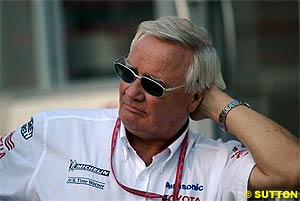 Andersson became involved in motorsport in a way familiar to many Scandinavians - he simply took his car out and went racing in local rallies near his home town of Uppsala, Sweden. Starting in 1962 he worked his way up through the ranks, eventually joining the Lancia works team in 1967 (with whom he won the Spanish Rally) and fitting in sports car races (most notably the Daytona 24 Hours) whenever the calendar allowed.
Andersson became involved in motorsport in a way familiar to many Scandinavians - he simply took his car out and went racing in local rallies near his home town of Uppsala, Sweden. Starting in 1962 he worked his way up through the ranks, eventually joining the Lancia works team in 1967 (with whom he won the Spanish Rally) and fitting in sports car races (most notably the Daytona 24 Hours) whenever the calendar allowed.
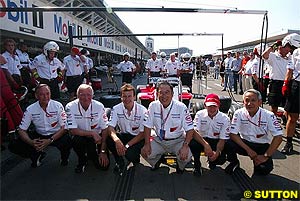 The effort paid off - TTE won four driver's championships, three manufacturer's championships, and an astonishing 43 wins before withdrawing from the series in 1999.
The effort paid off - TTE won four driver's championships, three manufacturer's championships, and an astonishing 43 wins before withdrawing from the series in 1999.
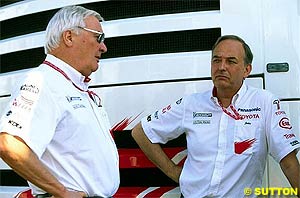 The importance of this one decision can be seen by the direction Formula One has taken since that time - Renault is constructing everything in-house under their own name, as is Jaguar (with the help of sister company Cosworth); Mercedes has a substantial shareholding (which is rumoured to increase in the very near future) in partner McLaren, and BMW have moved to strengthen ties with partner Williams in what many assume will be a prequel to buying into the company. The major manufacturers have since seen the light PR-wise of Andersson's prescient decision.
The importance of this one decision can be seen by the direction Formula One has taken since that time - Renault is constructing everything in-house under their own name, as is Jaguar (with the help of sister company Cosworth); Mercedes has a substantial shareholding (which is rumoured to increase in the very near future) in partner McLaren, and BMW have moved to strengthen ties with partner Williams in what many assume will be a prequel to buying into the company. The major manufacturers have since seen the light PR-wise of Andersson's prescient decision.
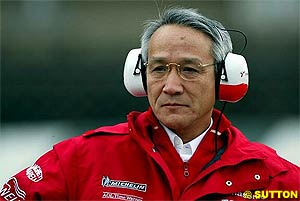 Time was finally called on 19 December 2003, when the team quietly slipped out a press release stating that Tsutomu Tomita, chairman of TMG, was to take over Andersson's position in the new year. Tomita commented that "we can not thank Ove enough for his contribution to Toyota Motorsport's activities and achievements. Ove's move is along the lines of Toyota's policy which sees its employees taking up new roles at certain points in their career within the company. From next season I will manage both the company and the race activities together with President John Howett."
Time was finally called on 19 December 2003, when the team quietly slipped out a press release stating that Tsutomu Tomita, chairman of TMG, was to take over Andersson's position in the new year. Tomita commented that "we can not thank Ove enough for his contribution to Toyota Motorsport's activities and achievements. Ove's move is along the lines of Toyota's policy which sees its employees taking up new roles at certain points in their career within the company. From next season I will manage both the company and the race activities together with President John Howett."
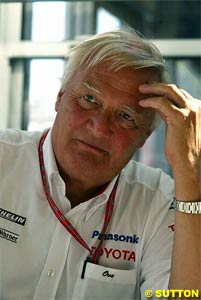 Richard Cregan, who has been friends with the man for half his life, explained the situation thus: "We had a situation where Ove was at the retirement age within the TMC companies, and the great thing is we've kept him as an advisor so we get the best of both worlds - we have Tomita now as Team Principal, and his experience and relationship with TMC obviously is a great influence for us, and we've kept Ove as well - so we've got the best of both worlds.
Richard Cregan, who has been friends with the man for half his life, explained the situation thus: "We had a situation where Ove was at the retirement age within the TMC companies, and the great thing is we've kept him as an advisor so we get the best of both worlds - we have Tomita now as Team Principal, and his experience and relationship with TMC obviously is a great influence for us, and we've kept Ove as well - so we've got the best of both worlds.
 DC: How does it feel to watch this car launch, the first one that's not under your control?
DC: How does it feel to watch this car launch, the first one that's not under your control?
Please Contact Us for permission to republish this or any other material from Atlas F1.
|
Volume 10, Issue 3
Articles
A Farewell to Arms?
Technical Analysis: Toyota TF104
Technical Analysis: Jaguar R5
Interview with Ron Tauranac
2004 Countdown: Facts & Stats
Columns
The Fuel Stop
The F1 Trivia Quiz
On the Road
Elsewhere in Racing
> Homepage |